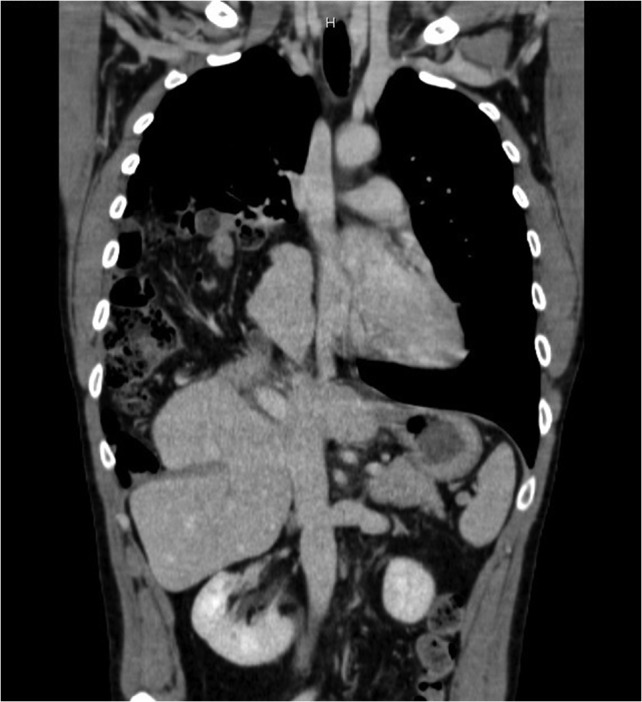Abstract
Right diaphragmatic hernia is an uncommon injury following abdominal trauma. A case of delayed right post-traumatic diaphragmatic hernia is presented. The patient referred us with wheezing and cough since 1 month. A chest-abdominal computed tomography scan demonstrated a large diaphragmatic defect with liver and intestinal dislocation. The patient underwent surgical intervention with diaphragmatic repair. No complications were observed during admission and follow-up is actually negative for recurrence.
INTRODUCTION
Diaphragmatic hernia is a rare consequence of thoraco-abdominal trauma. The abdominal organ herniation trough the right diaphragm is even rarer due to the liver protective function [1].
The high morbidity and mortality of this condition require early diagnosis and rapid treatment. The case reported concerns about a patient suffering from massive delayed right diaphragmatic hernia with right liver and bowel dislocation.
CASE PRESENTATION
A 41-year-old patient was referred to our Emergency Department with complaints of wheezing and cough since 1 month. During a previous admission, a diagnosis of right basal pneumonia was done.
His medical history was significant for motorcycle accident ~20 years before involving and bladder rupture. Thoracic examination revealed decreased breathing sound and bowel sound in the right lower hemithorax.
A chest X-ray revealed right basal consolidation with inhomogenous opacity at the medium and lower chest area.
A computed tomography (CT) scan demonstrated massive right diaphragmatic hernia with dislocation of the liver that appeared overturned ~180°, transverse and ascending colon and part of small bowel (Fig. 1).
Figure 1:

Thorax and abdominal CT showing the dislocation of right upper abdominal viscera
He was then admitted to the surgery department for a laparoscopic exploration that confirmed the radiological finding of inveterate right diaphragmatic hernia with an 8 cm defect. Because of the impossibility to reduce the liver in abdomen, due to the thoracic adhesions, a right anterolateral thoracotomy was then performed. The liver was uneventfully reinstated and colon and small bowel were replaced in anatomical position. The defect was repaired by dual mesh patch (15 × 25 cm). The postoperative course was uneventfully. Postoperative oxygen saturation was normal and a chest X-ray was performed before discharge and revealed complete re-expansion of the lung. The patient was discharged on the ninth postoperative day. The follow-up is negative for signs of recurrence after 2 years.
DISCUSSION
The diaphragmatic hernia is the herniation of abdominal organs into the chest through a diaphragmatic defect. These can be congenital or acquired [2].
Acquired diaphragmatic hernia occurs, in most of the cases, as a result of blunt or penetrating thoraco-abdominal trauma. The likelihood of occurrence of diaphragmatic hernia may be ~5% following high impact trauma [3]. Left hemidiphragmatic hernia is more common because liver exerts a protective function against the herniation of the viscera [1].
Herniation of the abdominal organs may be completely asymptomatic; due to this reason, ~66% of diaphragmatic rupture are not recognized at the time of trauma. The chest negative pressure causes the gradual migration of abdominal contents leading to the onset of symptoms [4]. We can classify this clinical condition in two types: Type I (early) and Type II (delayed). Dislocation of abdominal organs is more common in Type II hernia [1].
Clinical presentation includes gastrointestinal symptoms (abdominal pain, nausea, vomiting and sub-occlusion), respiratory (dyspnea, orthopnea and chest pain) or cardiocirculatory (hemodynamic compromission) [1–4].
The initial diagnostic tool is chest or abdominal X-ray but CT scan is the best modality to assess the extent of dislocation, the size of diaphragmatic defect and the belt-like constriction of abdominal contents, referred to as the ‘collar sign’ [3].
Surgery is always necessary for the treatment; the approach could be laparotomic/thoracotomic or minimal invasive. In our case, minimally invasive approach was used as a diagnostic tool in order to evaluate the diaphragmatic defect and choose the best approach (thoracotomic or laparotomic). In delayed case, diagnosis may be a compulsory thoraco-abdominal approach in order to lyse adhesions between abdominal organs and thoracic structure [2]. Defects >25 cm2 may require prosthetic repair [4].
CONCLUSION
Diagnosis of diaphragmatic hernia should always be considered in patient with chest or abdominal trauma because the mortality rate can reach 31% in the first 24 hours following the trauma. It should also be considered many years after trauma in case of onset of typical symptoms [5].
CONFLICT OF INTEREST STATEMENT
None declared.
REFERENCES
- 1. Peker Y, Tatar F, Kahya MC, Cin N, Derici H, Reyhan E. Dislocation of three segments of the liver due to hernia of the right diaphragm. Hernia 2007;11:63–5. [DOI] [PubMed] [Google Scholar]
- 2. Katukuri GR, Madireddi J, Agarwal S, Karren H, Devasia T. Delayed diagnosis of left-sided diaphragmatic hernia in an elderly adult with no history of trauma. J Clin Diagn Res 2016;10:PD04–PD05. [DOI] [PMC free article] [PubMed] [Google Scholar]
- 3. Wardi G, Lasoff D, Cobb A, Hayden S. Traumatic diaphragmatic hernia. J Emerg Med 2014;46:80–2. [DOI] [PubMed] [Google Scholar]
- 4. Thoman DS, Hui T, Phillips EH. Laparoscopic diaphragmatic hernia repair. Surg Endosc 2002;16:1345–9. [DOI] [PubMed] [Google Scholar]
- 5. Rubens de Nadai T, Paiva Lopes JC, Inaco Cirino CC, Godinho M, Rodrigues AJ, Scarpellini S. Diaphragmatic hernia repair more than four years after severe trauma: four case reports. Int J Surg Case Rep 2015;14:72–6. [DOI] [PMC free article] [PubMed] [Google Scholar]


